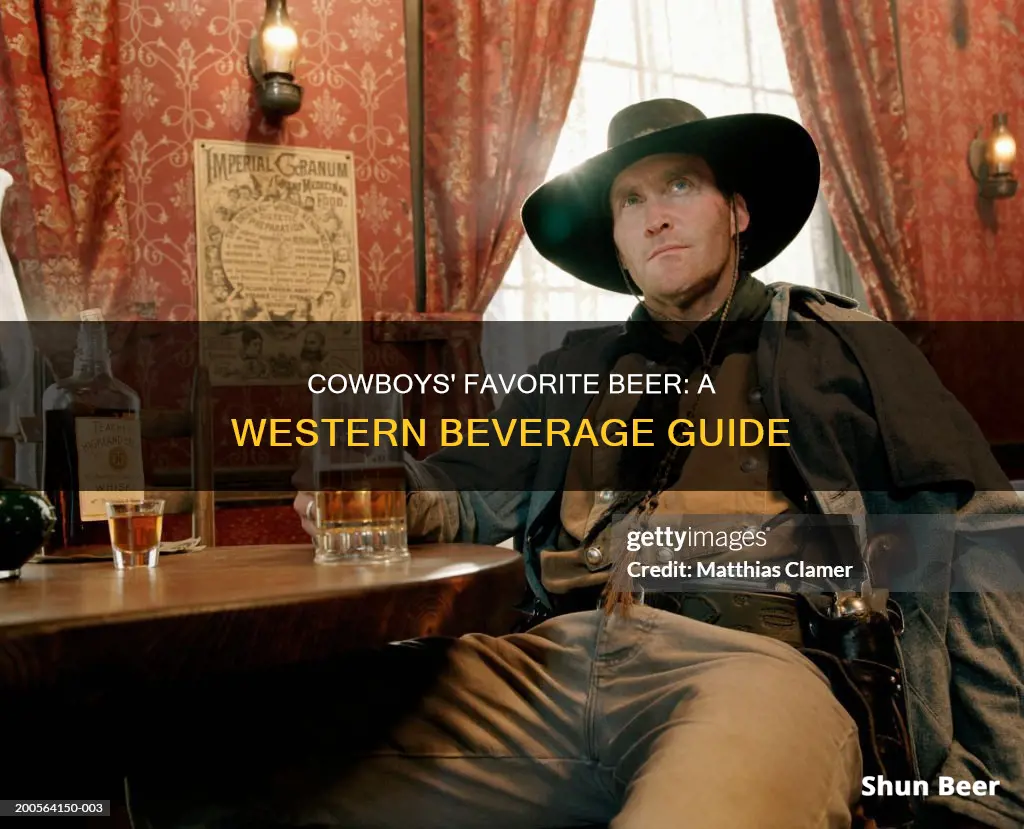
The Wild West and its cowboys are often associated with whiskey, but beer was also a popular drink of choice. In fact, beer was widely consumed in Western saloons and was even preferred by some cowboys over whiskey. The beer consumed by cowboys in the 1800s varied depending on the region and availability of resources. In some remote areas, beer was home-brewed and lacked hops due to the hot climate, resulting in a sweet taste similar to whiskey mash. However, with the increasing migration of German immigrants, who were skilled brewers, to the West and neighbouring states like Wisconsin and Missouri, beer began to be kegged and transported westward, improving the quality and variety of beer available.
| Characteristics | Values |
|---|---|
| Beer names | John Barleycorn, purge, hop juice, calobogus, wobbly pop, mancation, let’s mosey, laughing water, mad dog, Jesus juice, pig’s ear, strike-me-dead, heavy wet |
| Beer cost | 10 cents per glass |
| Beer temperature | Room temperature |
| Beer type | Lager or ale, dark or pale, hopped or sweet |
| Beer production | Home-brewed, kegged, bottled |
| Beer dilution | With “enhancers” or water |
| Beer consumption | Drunk quickly before it got too warm or flat |
| Beer refrigeration | Commercially available from 1870 |
| Beer transportation | Kegs, barrels, bottles |
| Beer containers | Kegs, barrels, bottles, glasses |
| Beer drinking places | Saloons, bars |
| Beer drinking reasons | Thirst, health, medicinal |
What You'll Learn

Beer was often home-brewed and unhopped
In the outer reaches of the early West, beer was often home-brewed and unhopped. This was because hops didn't grow well in many hot places, and the beer was made from lower-quality grains not used for bread-making. The brew would have tasted sweet, like a whiskey mash before distillation.
Beer in the Old West suffered the same "bastardizations" as whiskey. Saloon keepers and bartenders would dilute beer with "enhancers" or water to maximise their profits. In 1870, a glass of beer cost about 10 cents, which is about $1.77 in today's money. Beer was also not bottled until 1873 and was mostly kept in kegs, sometimes stored in barrels that patrons would sit upon.
Beer in the West was largely dependent on where you were. In the outer reaches, it was often home-brewed and unhopped, but as more German immigrants moved West, kegged beer started to pick up in popularity. German brewers introduced better grains, water sources, yeasts, and hops, brewing mostly lagers. As keg beer began to show up in saloons, patrons noticed the marked improvement of the professionally brewed beer over the previous home-brews, which had been mostly rancid and weak.
Saloons in the US began to have a close association with breweries in the early 1880s. The brewing industry was growing so rapidly that competition became very keen. Breweries began to adopt the British "tied-house" system of control, where they owned saloons outright.
Beer Drinking in Minnesota State Parks: What's Allowed?
You may want to see also

Beer was served at room temperature
Beer was not served cold in the Old West. Up until the 1870s, beer was served at room temperature, in the European tradition. While the beer had a head, it was not sudsy like it is today. This meant that patrons had to drink the beer quickly before it got too warm or flat.
The first commercial refrigeration of beer began in 1870 at the Liebmann's Sons Brewing Company in Brooklyn, New York. The beer was fermented cold, shipped cold, and eventually stored and served cold. Anheuser-Busch and other major breweries soon followed suit. However, refrigeration took decades to become widespread in the West. In the meantime, ice houses began to appear, even in the most isolated places, and some towns and cities harvested ice in winter from their rivers, storing it in caves or deep stone cellars.
Cowboys, who spent their days sweating in leather chaps and eating dust in the saddle, would have welcomed a cold beer at the end of the day.
Beer After Dinner: A Healthy Choice?
You may want to see also

Beer was often diluted with enhancers or water
In the Old West, beer was often diluted with "enhancers" or water by saloon keepers and bartenders to maximise their profits. Beer was usually sold by the glass, costing about 10 cents, or about $1.77 in today's money.
Beer was not bottled until 1873 and was mostly kept in kegs, sometimes stored in barrels that patrons would sit upon. Beer was also served at room temperature in the European tradition and had to be consumed quickly before it got too warm or flat.
The first commercial refrigeration of beer began in 1870 at the Liebmann's Sons Brewing Company in Brooklyn, New York. It was fermented cold, shipped cold, and eventually stored and served cold.
While beer was a popular drink in the Old West, it often suffered from the same issues as whiskey, with bartenders adding enhancers or water to increase their profits. This practice may have led to the perception that beer was a lower-quality drink, and it was also served at room temperature, which may have further reduced its appeal.
However, as German immigrants moved West and introduced better brewing techniques, the quality of beer improved. German brewers introduced better grains, water sources, yeast, and hops, which resulted in professionally brewed beer that was a marked improvement over the previous home brews.
Thawed Beer That Burst: Is It Still Drinkable?
You may want to see also

Beer was stored in kegs or barrels
Patrons would have to drink the beer quickly before it got too warm or flat. This was especially true in the hot places typical of the Wild West, where cowboys would pay a premium for a cold beer after a long day of work.
The first commercial refrigeration of beer began in 1870 at the Liebmann's Sons Brewing Company in Brooklyn, New York. The beer was fermented cold, shipped cold, and eventually stored and served cold. Anheuser-Busch and other major breweries soon followed suit.
While refrigeration took decades to become widespread in the West, ice houses began to crop up even in the most isolated places. Some towns and cities harvested ice from rivers in the winter and stored it in caves or deep stone cellars.
Beer and Bupropion SR: Is It Safe to Drink?
You may want to see also

Beer was popular with cowboys after a long day in the heat
Beer was popular with cowboys after a long, hot day in the saddle. The West was a hot place in summer, and cowboys would pay a lot for a cold beer after sweating in leather chaps and eating dust all day. Beer was also a welcome refreshment in the saloons of frontier towns.
In the early West, beer was often home-brewed and devoid of hops, as they didn't grow well in many hot places. Most brews would have been made from lower-quality grains not used for bread-making, and they would have tasted sweet like a whiskey mash before distillation. However, as more German immigrants, who knew the art of brewing, moved West, kegged beer started to pick up in popularity. German brewers introduced better grains, better water sources, better yeasts, and hops. They brewed mostly lagers, and as keg beer began to show up in saloons, patrons noted the marked improvement of the professionally brewed beer over previous home brews.
Beer was not bottled widely until 1873. Up to that point, it was mostly kept in kegs, sometimes stored in barrels that patrons would sit upon. Beer was served at room temperature until the 1870s, so patrons had to drink it quickly before it got too warm or flat. The first commercial refrigeration of beer began in 1870, and it would be fermented cold, shipped cold, and eventually stored and served cold. However, refrigeration took decades to reach many places in the West.
Beer in the Old West had many colourful nicknames, including John Barleycorn, purge, hop juice, calobogus, wobbly pop, mancation, let's mosey, laughing water, mad dog, Jesus juice, pig's ear, strike-me-dead, and heavy wet.
Beer and Workouts: Light Beer's Impact on Fitness
You may want to see also
Frequently asked questions
In the outer reaches of the early West, most beer was home-brewed and devoid of hops since they didn't grow well in many hot places. Beer was also imported from Scotland.
Yes, cowboys also drank sarsaparilla, a medicinal drink made from the dried root bark of several plants in the genus Smilax. It was supposed to cure anything from stomachaches to STIs.
In addition to beer, whiskey, and sarsaparilla, saloons also served wine, gin, ginger mixes, soda water, and mineral water.







